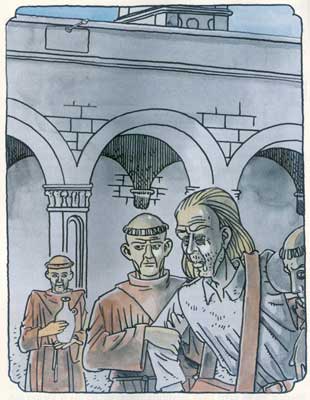
LAST
SUPPER OF THE
ISLAND OF HVAR
'Last Supper' the painting from the island of Hvar is one
of the greatest masterpieces on the Adriatic coast, preserved
through the centuries. The painting is kept in the dining-hall
of Hvar's Franciscan Monastery, although its' author cannot
be attributed with certainty to this very day.
 There
was a painter, a Venetian, renowned in his own era, who worked
in the Middle East. When he started to suspect that he caught
the plague, he got terrified and ran to see a doctor in the
Egyptian Port Said. The doctor gave him a certificate, enabling
him to embark the sailing ship leaving for Italy. The painter
took only his painting kit, colours and brushes with him.
His fever had already worsened when the ship was leaving Port
Said, and after a week, when the ship sailed within reach
of the islands of Korcula and Hvar, travellers denounced his
illness. There
was a painter, a Venetian, renowned in his own era, who worked
in the Middle East. When he started to suspect that he caught
the plague, he got terrified and ran to see a doctor in the
Egyptian Port Said. The doctor gave him a certificate, enabling
him to embark the sailing ship leaving for Italy. The painter
took only his painting kit, colours and brushes with him.
His fever had already worsened when the ship was leaving Port
Said, and after a week, when the ship sailed within reach
of the islands of Korcula and Hvar, travellers denounced his
illness.
There was no physician on the ship, and so the decision of
the patient's destiny had to be brought up by the captain.
The maritime laws of that time were tightened up to the very
limits, due to the big plague epidemic. The traveller who
died of plague on the ship would be thrown into the sea. If
any other traveller was infected, he would also be thrown
into the sea, as well as any other people who came into contact
with the illness, in order to save the rest of the people
aboard.
The captain's decision was forestalled by a strong cyclone,
and so he decided to cast anchor some 200m from Hvar's port,
on the small island of Galesnik, that was used as a ship's
quarantine during the Middle Ages. The sailing ship stayed
there for 40 days, exactly as prescribed by the rules, and
since it was ascertained that not one of the 150 passengers
and crew members got infected, they were free to move on.
Sailors disembarked the painter on the shore of Hvar in a
helpless and almost unconscious state.
Exhausted from his illness, he wandered from one house to
another. All the doors shut in front of him, because everyone
saw him as a source of infection, the possibility of the quick
spreading of the plague. Nobody on the whole island wanted
to be his host, and the local doctor stated that he was going
to die. The painter also became convinced that he was going
to die very soon. On the second or third day of his wandering,
almost crawling, the languished painter knocked on the last
doors. Those were the doors of the monastery.
Friars received this stranger as if he was their own brother,
and succeeded to heal him with their medicines in a few weeks.
Thankful for his miraculous healing, the artist decided to
repay his debt. From Italy he ordered a big canvas, 8 meters
long and almost 2 meters high. As a sign of his thankfulness,
he worked for months and painted a painting in a tempera technique.
The painting portrayed the motif of Christ's Last Supper in
the company of his twelve apostles, and everyone who sees
it admires it to this very day.
The painting covers an entire wall of the monastery's dining
hall, and all the faces are portrayed in their natural proportions.
It is assumed that the painter painted his self-portrait in
the lower right-hand corner - in the shape of a poor man who
is lying on the floor and returning the bowl to the apostle
Matthew, his protector.
|













